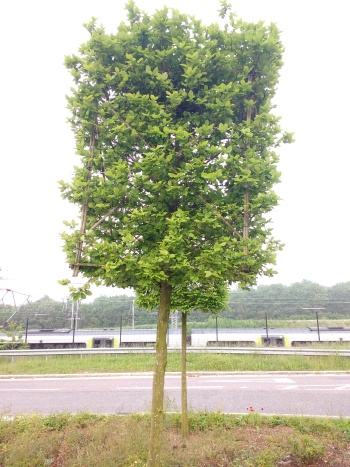
Oddly fashionable shaped hornbeam promotes deep reflection on trees and wood
I was struck by the completely amazing nature of trees and wood in a kind of revelatory way this morning, brought about by some odd but trendy box hornbeams in central Milton Keynes. These are a rather extreme example of trees’ generosity – especially if you like your trees cubic.
If a material scientist or engineer was asked to create something that does even part of what a tree manages to do, they might shy away, but to come up with one thing that is capable of all the amazing stuff that trees as a group of organisms manages would be a tall order indeed. Actually the term ‘tree’ is pretty vague but for the purposes of this post, I think most people will be happy with it.
So I’m going to ask this poor material scientist to contrive a substance that is strong enough to be used in the structure of a house or ship, yet light enough also to build an aeroplane. It needs to be soft enough to be carved into fabulously intricate forms for purely aesthetic as well as mechanical reasons. It must, in some cases, be capable of remaining intact after many years in the ground or underwater. It must be somewhat fire resistant and at almost the same time, burn pleasantly to warm the chilled bones of the bloke who did the harvesting and it will need to be a fine cooking and commercial heating fuel.
It must be workable to produce (with a little skill and love) a most beautiful, polishable finish that will be desirable around the house as well as being light and safe enough for use by a child.
Some forms must be capable of being woven into strong baskets and even knotted, yet others should be flexible enough to form barrels and bows and oars and masts and brooms and tool handles…
In the manufacture of this material, carbon neutrality must be exceeded; the factory should be carbon negative, that is, it should remove carbon from the atmosphere and deposit oxygen in its place. A bit of atmospheric pollution removal would be helpful too and throw in some noise damping for good measure. The factory should be able to draw materials from deep in the soil and when faced with wind or flood it should hold that very soil together. It must reduce the blood pressure and shorten the time of recovery of those humans lucky enough to look onto it – they should also love being on the shop floor. As well as all of that, the production plant will need to provide homes and food for a massive range of organisms. That should do the job just fine.
Oh, just a final thought…
..the factory must be capable of appearing without any assistance from humans in just a few years.
